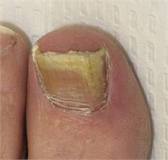Proximal Subungual Onychomycosis (Nail Fungus)
Proximal Subungual Onychomycosis (Nail Fungus)
 Least common in people with healthy immune systems but found frequently in people who have compromised immune systems, proximal subungual onychomycosis stands out because the progression of the disease starts at the cuticle and grows out with the nail.
Least common in people with healthy immune systems but found frequently in people who have compromised immune systems, proximal subungual onychomycosis stands out because the progression of the disease starts at the cuticle and grows out with the nail.
Proximal subungual onychomycosis usually causes the nail to become disfigured, as in other nail fungus infections, but as it starts at the cuticle and works its way up, it is more likely to infect the nail bed early on, causing the nail bed to develop bumps and irregularities. This then may cause the nail plate to become dislodged and fall off, exposing the nail bed to possible further infection.
Similar to distal subungual onychomycosis, the majority of cases of proximal subungual onychomycosis are caused by the same dermatophyte, Trichophyton ruburm. However this particular nail fungus infection can also be caused by a different dermatophyte, Trichophyton mentagrophytes. Proximal subungual onychomycosis can also be caused by molds. Another defined symptom of proximal subungual onychomycosis is the skin around the nail may become swollen, red and inflamed and may start to ooze pus. This is more commonly seen when the nail fungus infection is caused by molds than by dermatophytes.
Unfortunately, these distinguishing symptoms are what cause proximal subungual onychomycosis to be misdiagnosed as a bacterial infection instead of a fungal infection by some physicians. As antibiotics do not kill fungi, this course of treatment does nothing to stop the infection. An antifungal is required to eradicate molds, yeasts and dermatophytes.
Proximal subungual onychomycosis occurs more often in people who have depressed or deficient immune systems. It is rarely seen in people with good immunity. Immunodepression can be caused by procedures like chemotherapy or in people who are recovering from an autoimmune disease or an organ transplant and have had their immune system deliberately suppressed.
Proximal subungual onychomycosis occurs frequently in people with unhealthy immune systems and even more commonly in people with human immunodeficiency virus or HIV. This is such a common occurrence that if a patient contracts this form of nail fungus infection and no other cause can be found, the doctor will likely suggest an HIV test. Be prepared if you have a fungal nail infection and it is discovered to be proximal subungual onychomycosis, to have your doctor suggest an HIV test. This is a test that requires your consent to perform. And just because you may receive a diagnosis of proximal subungual onychomycosis doesn’t necessarily mean that you have contracted HIV.
The only way to cure proximal subungual onychomycosis is to take an oral antifungal medication. If the nail fungus is caused by dermatophytes Trichophyton rubrum or Trichophyton mentagrophytes then it is likely that your doctor will prescribe terbinafine, also known as Lamisil. The dose is usually one 250 mg pill once a day for six weeks for a fingernail infection and twelve weeks for a toenail infection. A nice thing about Lamisil is that it is usually less expensive than the other current generation antifungals.
Itroconazole, or Sporanox, is used for treatment when the cause of the proximal subungual onychomycosis is unknown because it is effective against both dermatophytes and Candida infections. This tends to be a more expensive treatment method than some of the others.
Fluconazole commercially known as Diflucan, is able to treat proximal subungual onychomycosis but is not used as often as the other available medications. This medication stops the fungal growth and therefore the spread of the disease but does not kill the fungus itself. The difference between these two processes is referred to as fungistatic (stopping growth) and fungicidal (killing growth).
This particular drug tends to slow down the growth so that the immune system can take care of it on its own. As many of the cases of proximal subungual onychomycosis happen in people with previously depressed immune systems, this is not necessarily the best drug choice. Fluconazole (Diflucan) is taken until the symptoms resolve and the infection is gone.